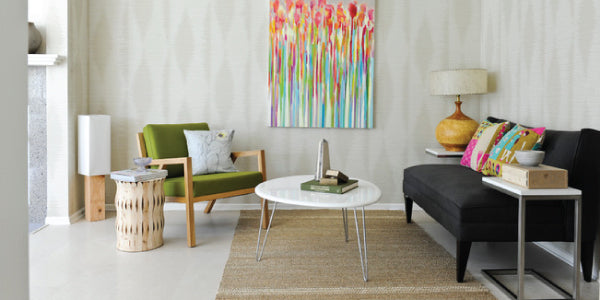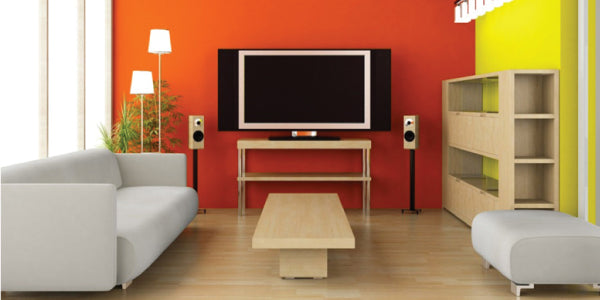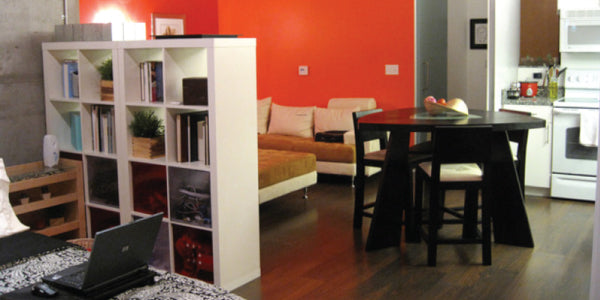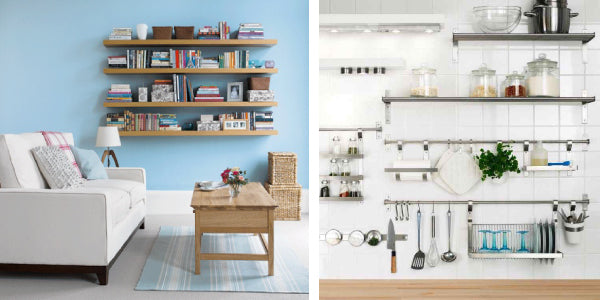June 25, 2014
Small spaces are great--they're economical, easy to manage, and allow you to live where the action is without paying the premium. With these six tips, not only will you be saving on your heating bill, you'll be doing it in style and with surprising legroom.

Speaking of legs, an easy way to increase the perceived size of a room is to create open or negative space-- and a great way to accomplish that is with legged furniture. Sure, that squat recliner may be comfortable, but it will make the room feel smaller and more crowded .

It stands to reason that using lighter colors will enhance the airiness of a room, reducing the cave effect of a dark color, but pale doesn't mean boring. Using a bright--not light--color and bold patterns will call attention to the wall and not the tightness of the room. Different colored paint is also a really nice way to divide the room into smaller sections, making a single-room loft or studio seem less like one big box. Use corners as defined areas and accent walls; change the color and create smaller spaces within the larger one.

Don't just use paint to create spaces within the whole--organize your furnishing into clusters; a small dining nook, a couch facing the television, an area rug with a reading lamp and soft chair. By creating differentiated areas and not just lining your walls with furniture, one room becomes many and you aren't left with a big empty area in the middle of the room.

In a small apartment, it is easy to accumulate clutter; with little storage space, just a couple of extra purchases can have a big impact. The buildup of stuff will quickly look chaotic and messy - making the room you've spent so much time making look big look cramped instead. It is the same principle used when choosing furniture with legs: open space makes a room look airy and larger than it is; the opposite does, well, the opposite.
Keep on top of your cleaning—remember, a small apartment will look messy much faster than a larger one. Once that apartment is clean, work on creating priorities for your space. Be very conscious of what you're purchasing and how important or necessary that item is - is it worth the room it will take? Is it important enough to replace something you already have? Do the arithmetic, and not only will you save room, you'll save money.

Going back to our first tip, conserve as much floor area as possible for larger grounded items such as couches and tables. Anything that can go on the wall, hang from the ceiling, or from under a cabinet, should. Hang pots and pans from hooks, purchase a microwave that attaches to the underside of your kitchen cabinet, put up wall shelves for your books instead of using a big book case.

There is no rule that states that furniture shall have only one function. In small spaces, multi-functional furniture is your best friend. A mattress that folds; an ottoman that is also a storage area; storage drawers that fit under the bed; a dining table that doubles as a desk are great space-saving options. Look to other cultures, such as Japan, where they sleep on shikibutons - thin futons that can be folded up in the morning and stored in a closet - for inspiration.
With a little planning and creativity you can make a small space feel large and open, comfortable and chic. Don't let the square footage of your apartment define you, use your style and imagination to create a place you'll love to spend time in and enjoy with friends.Comments will be approved before showing up.
September 29, 2025
One of the easiest and most impactful changes you can make in your home is swapping out synthetic dryer sheets for a set of 100% wool dryer balls. With every load, these dryer balls help reduce drying time, soften fabric naturally, and eliminate the need for synthetic additives - all while being reusable, compostable, and zero-waste.
September 22, 2025
Our Ballard team has joined forces with our Edmonds Showroom, now open 7 days a week as our Flagship Store!
April 11, 2025
We’re proud to offer Wool Pillows and Toppers that are OEKO-TEX® STANDARD 100 certified. This certification isn’t just a label—it’s a promise. It’s one more way we ensure that the materials touching your body every night are truly safe, non-toxic, and made with integrity from start to finish.
Visit us at our
425-292-2808
111 Main Street Plaza, Suite 101 Edmonds, WA 98020